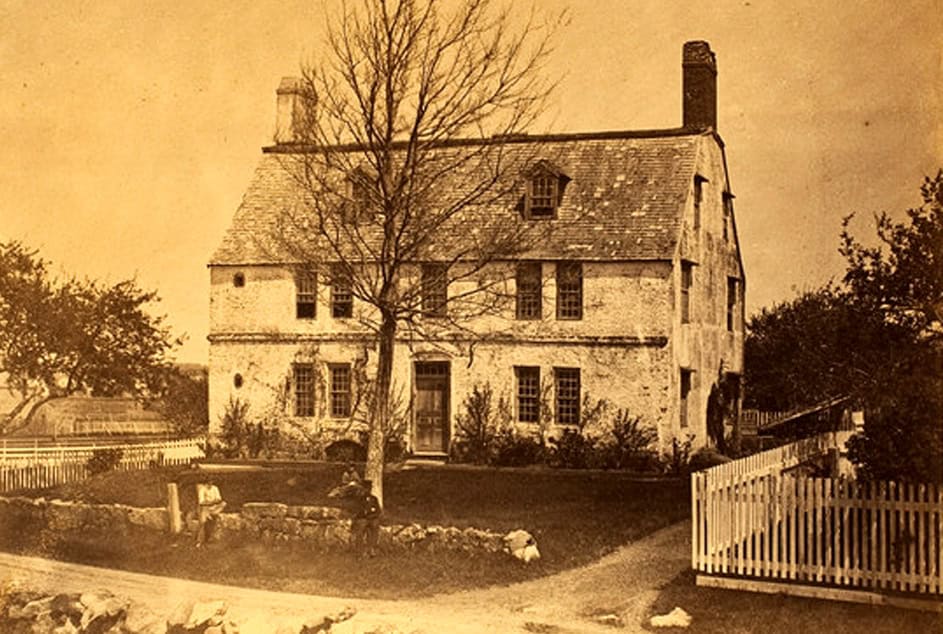Development of Charlestown, Part 13
By Inna Babitskaya
(Note from The Advocate: The source of the quotations is Richard Frothingham, Jr.’s “The History of Charlestown, Massachusetts” [1845] except where a source is otherwise noted.)
Some of the first settlers of Charlestown left invaluable memoirs where they described the newly founded town as well as New England. Thus, William Wood (1580–1639), who came to New England in 1628, was one of the first authors who wrote about Massachusetts. In 1633, he returned to England, where in 1634 he published “New England’s Prospect,” in which he in detail told about New England’s geography, botany, biology and anthropology. He gave the following description of Charlestown: “On the north side of Charles River is Charles Towne… At this town there is kept a ferryboat to convey passengers over Charles River, which between the two towns is a quarter of a mile over, being a very deep channel. Here may ride forty ships at a time. Up higher, it is a broad bay, being above two miles between the shores, into which runs stony-river and muddy-river. Towards the south-west in the middle of this bay is a great oyster bank.”
Captain Edward Johnson (1598–1672), also shared his view of Charlestown in his “Wonder-Working Providence of Sion’s Savior in New England, 1628–1651” (published in 1654): “The form of this Town … is like the Head, Neck and Shoulders of a Man, only the pleasant and Navigable River of Mistick runs through the right shoulder thereof, and by its near approach to Charles River in one place makes a very narrow neck, by which means the chief part of the Town, whereon the most building stands, becomes a Peninsula: it hath a large Market-place near the water side built round with Houses, comely and faire, forth of which there issues two streets orderly built with some very faire Houses, beautified with pleasant Gardens and Orchards, the whole Towne consists in its extent of about 150 dwelling Houses.”
Since the very beginning, the colonists created rules regarding the land’s division. In 1629, it was agreed that each inhabitant should have two acres for planting ground and to fence in common. In 1630, each “dwelling within the Neck” should have “two acres of land for a house plot and two acres for every male that is able to plant.”
According to the Massachusetts Bay Company, each person who arrived to the colony at his own cost “was entitled to fifty acres; each adventurer of fifty pounds in the common stock, to two hundred acres, or in this proportion; those who brought over servants were allowed fifty acres for each, and grants were made, also, in consideration of eminent service rendered the Colony.” Following those rules, large parcels of land were granted to such prominent people as John Winthrop, Increase Nowell, John Wilson and Matthew Cradock by the General Court before the bounds of the town were established.
John Winthrop (1588–1649), an English Puritan lawyer and cofounder of the Massachusetts Bay Colony, was the governor of the colony since October 1629 and led a group of few hundred people to the colony in April 1630 (Winthrop Fleet). He received 600 acres along the southern bank of the Mystic River, where he built his summer residence called “Ten Hills Farm” (now Medford and Somerville). His winter house was located in Boston. In 1632, Winthrop received an island in Boston Harbor (the “Governor’s Island”). In 1638, he got 1,200 acres of land along the Shawsheen River (now Billerica and Concord).
Matthew Cradock (1585–1641), a London merchant, a politician, the first governor of the Massachusetts Bay Company and one of the principal investors in the Mass Bay Company, owned property and businesses in New England. He acted on the company’s behalf in London. He had 18 ships and conducted trade with the West Indies, North America, Europe and the Near East. Cradock got very large land lots (200 acres for every 50 pounds invested) that included nearly all modern Medford (where was located the first shipyard). He also owned land in Marblehead, Ipswich, Agawam and Kennebunk.
Four hundred acres of land near the west side of the North River, “Three Myle Brooke,” were granted to two outstanding residents. One was Rev. John Wilson (1588/91–1667), minister of the First Church of Boston (in 1630–67) and an ardent Puritan (known for his role in the trials of Anne Hutchinson and Mary Dyer). Another one was Increase Nowell (1590–1655), colonial administrator, patentee of the Massachusetts Bay Company, one of the founders of Charlestown and the first ruling elder of its First Church. “The Nowell grant, which was situated north of the Wilson lands, covered the present Edgeworth ward and extended out upon the Medford plain to the Cradock farm. The grants of Wilson and Nowell, forming a part of Charlestown on Mystic Side, separated Malden and Medford until 1726, when they were annexed to the former town.” (Deloraine Pendre Corey, “The History of Malden, Massachusetts: 1633-1785” 1899)
In 1633, the territory between Island End River and North River was granted to the town of Charlestown, and the next year an allotment in five-acre lots of land was made to the several inhabitants of Mystic Side (now Malden) and Mystic Field (now Medford). “In 1634, each inhabitant had ten acres of land allotted to him at ‘Mistick Side,’” but in 1635, “twenty-nine ‘willingly relinquished’ five acres of their ten acre lots ‘for the good of the town’ – ‘that it might supply new comers.’”
In 1635, the lines between Charlestown and Boston “ran from ‘one marked tree’ to another; from ‘the creek in the creek upward’ to ‘a little neck of land’; from ‘a tall pine upon a point of rock’ to ‘the other side of Rumney Marsh’; and ‘from outside to outside by a strait [sic] line.’”
According to the agreement of 1636, “the bounds… on the north-east side of the Mistick river, shall run from the marked tree upon the rocky hill above Rumney Marsh near the written tree no: no: west upon a straight line by a meridian compass up into the country.”
On March 3, 1636, it was decided that “Charlestown bounds shall run eight miles into the country, from their meeting-house, if not other bounds intercept, reserving the propriety of farms, granted to John Winthrop, Esq., Mr. Nowell, Mr. Cradock, and Mr. Wilson, to the owners thereof, as also free ingress and egress for the servants and cattle of the said gentlemen, and common for their cattle, on the back side of Mr. Cradock’s farm.”
After determination of the towns’ boundaries, lands were divided by their inhabitants according to the decisions of the town meetings. The special committees of the seven men usually surveyed and numbered the lots that were later given to the inhabitants. The sizes of the land grants were based on the family size, the number of cattle and other livestock, and inhabitant “eminent respect” (those who deserved it due to their descent and usefulness for the colony). Also, the General Court did not allow to build the dwelling house “above the distance of half a mile or a mile at the furthest” from the congregational meeting house.
Some residents could own 15 lots, while others owned half a lot; and no one could dispose of his lot until he had built and planted it in town. The lots could be sold only to inhabitants of the town, and the sellers had to “resign up half their ten acre lots on Mistick Side, for the accommodation of such brethren that want.”
There were also strict rules regarding the residence. Thus, the potential residents had to have the corresponding credentials, such as church membership, good moral character, or even the obligation to bring wives from abroad. While at that period of time the religious belief meant more than the poverty, later the paupers could not be allowed to settle in the towns. On October 13, 1634, it was ordered “that none be permitted [to] sit down and dwell in this town without the consent of the town first obtained.”
Since February 21, 1637, the rules became even more strict. It was forbidden abroad to entertain people in the freemen’s houses without the notification of the town meeting and without getting consent of the three selectmen. From April 3, 1638, freemen were not allowed to entertain anybody at their houses without prior notice to the selectmen within 14 days; those who were not freemen had to get consent of six selectmen. The city constable should observe the fulfillment of that rule, and the violators were fined. According to the General Court, people from abroad could not settle in any town without the consent of one member of the council, or two magistrates, under penalty of one hundred pounds.
To be continued…
(Inna Babitskaya is a Malden Historian, a member of Malden Historical Commission and the author of historical books “From Maldon to Malden,” “Time of Converse” and “Fellsmere Park – Emerald of Malden.”)





